|
< Earlier Kibitzing · PAGE 2 OF 2 ·
Later Kibitzing> |
Dec-12-13
 | | Phony Benoni: Here is the story behind this game:
It was played in the next-to-last round. Pillsbury was in first place, leading Maroczy and Schlechter by a half-point. The latter two were to play in the last round, and could not have relished the thought of trying to beat each other in an attempt to overtake Pillsubry. The American had to be slowed down now. Maroczy, studying an earlier game of Pillsbury from the tournament, found a new line (14.b6 and 15.Nd5) which offered White a strong attack. He showed the analysis to Halprin, who followed it to the letter and totally surprised Pillsbury, who nonetheless managed to find his way through the complications at the board and draw the game. This draw eventually led to a triple tie for frist, leading to a playoff. See Munich (1900) for more details. |
|
Dec-12-13
 | | piltdown man: Great pun, if a little esoteric. |
|
| Dec-12-13 | | morfishine: <Phony Benoni> Nice work! Its difficult to comment on this game. Halprin was definitely no slouch ***** |
|
| Dec-12-13 | | SeanAzarin: Thank you, piltdown. That's the first time one of my puns has been used. I thought the game and the story behind it should be a GOTD. |
|
| Dec-12-13 | | dunican: Congrats, <SeanAzarin>, the pun is even better with the story behind. Nevertheless, as a Czech I cannot help feeling a touch of bitterness that's been an almost obligatory association with the words. |
|
| Dec-12-13 | | SeanAzarin: <dunican>, that's quite understandable. I'm sorry for everything that's happened to your country [including the later abuse it took from the Soviets.] Here's to hoping it never happens again. |
|
| Dec-12-13 | | solskytz: I see Dunican's point here. This is the second time in quite a short while, that a GOTD pun relates to the Nazi regime and its horror - although for the life of me I can't remember what was the first one. Maybe it's still in order to wait a hundred more years or so before putting any more "Nazi jokes" as GOTD puns - just maybe. |
|
| Dec-12-13 | | solskytz: Amazing game and astonishing sacrifices, so many of them... impossible to believe that this is all forced! What about ...Qc6 instead of exd5 on move 15? Black is already two pawns to the good. What will prevent him from castling to safety next move? |
|
| Dec-12-13 | | kevin86: White cannot win because he sacrificed too much-but he can save the draw. |
|
Dec-12-13
 | | Domdaniel: <SeanAzarin> Congrats -- a fine pun, an interesting game, and a fascinating backstory. |
|
| Dec-12-13 | | hedgeh0g: <solskytz> 15...Qc6? 16.Ne7!  |
|
| Dec-13-13 | | SeanAzarin: <dunican> and <solskytz>, you'll like this one better: M Lange vs Blackburne, 1883
I submitted it under "Judgment at Nuremberg". |
|
| Dec-15-13 | | solskytz: <SeanAzarin> You're right - it sounds better already! <Hedgehog> A nice tactic! I suppose you checked it with a computer so I won't bother. The move definitely looks impossible - but actually does seem to work. |
|
| Dec-16-13 | | hedgeh0g: <solskytz> No, it isn't computer-checked, so you might want to verify it, although I don't see a defence. Note that Qxc2 is met by a Rc1. |
|
| Dec-18-13 | | solskytz: The more I look at it, the more I get a sense of despair as to black's resources... |
|
| Dec-12-16 | | Straclonoor: Interesting opening but enough only for draw. Here is line -
Analysis by Stockfish 051216 64 POPCNT: = (0.00): 16.Rfe1+ Kf7 17.Re7+ Qxe7 18.Bxe7 Kxe7 19.f4 Kd7 20.Qxd5 Kc7 21.Ra3 Re8 22.Rc3+ Kd7 23.Qb5+ Kd8 24.Qd5 Re1+ 25.Kf2 Re2+ 26.Kf1 Re7 27.Qg8+ Kd7 28.g3 b5 29.Qxh7 b4 30.Rc4 Nf8 31.Qf5+ Ne6 32.Qb5+ Kd8 33.Qd5 Kd7 34.Qb5+ |
|
| Sep-01-18 | | rgr459: Russian collusion going on here |
|
Apr-21-19
 | | KEG: This was undoubtedly the game of the Munich 1900 tournament. As is discussed in the excellent introduction to this tournament by Phony Benoni on this site, going into this game in the penultimate 14th round, Pillsbury was A half-point ahead of Maroczy and Schlechter, who were schedule to play each other in the final (15th) round. All in all, it certainly appeared that Pillsbury (who would play Berger in the final round) was on course to win his first major international tournament since Hasting 1895. But, reportedly, Maroczy had examined Pillsbury's 12-round win against Wolf and had spotted and shared with Halprin an alternative to Wolf's 14. Ra3. Pillsbury must had suspected that something was afoot when Halprin repeated Wolf's play through move 13, but he nonetheless entered the line Maroczy had analyzed. To his great credit, Pillsbury navigated the pitfalls over the board and achieved a draw, ending up level with one round to go after Maroczy and Schlechter won their 14th round games. 1. e4 e5
2. Nf3 Nc6
3. Bb5 Nf6
4. 0-0 Nxe4
5. d4 Nd6
6. dxe5 NxB
7. a4 d6
8. e6 fxe6
9. axN Ne7
10. Nc3 Ng6
11. Ng5 Be7
12. Qh5 BxN
13. BxB Qd7
For a discussion of the first 13 moves, see Introduction to Munich 1900 by Phony Benoni and my notes to the Wolf-Pillsbury 12th round game. After 13...Qd7, the position was:
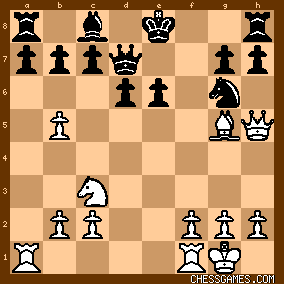
click for larger viewIn the game he lost to Pillsbury in Round 14, Wolf here played 14. Ra3. But Maroczy prepared something much better for Halprin: 14. b6
"!"--(Tournament Book)(wwall on this site)
"...marked out by Maroczy and Halprin in anticipation of trying it against Pillsbury." (Sergeant-Watts). "By this important thrust the cohesion of the black pawns is seriously disturbed." (Tartakower-DuMont). "14. b6 and 15. Nd5 were a total surprise (to Pillsbury)." (wwall). If instead 14. Nd5 0-0 leaves Black with better chances. (See Tartakower-DuMont). As wwall has pointed out, however, 14. Qf3 was also possible. 14... cxb6
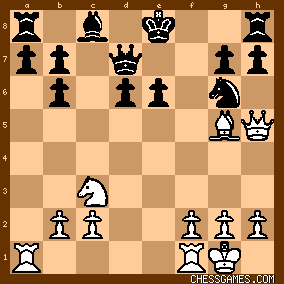
click for larger view15. Nd5
"!"--(Tournament Book).
"By this c=sacrifice the e-file is laid upon." (Tartakower-DuMont). "Attributed to Maroczy." (Sergeant-Watts).
"White threatens 16. Nxb6" (wwall).
This remarkable move deserves its own diagram:
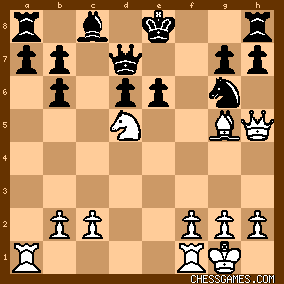
click for larger view16... exN
"If 15...Qc6 White wins with the following pretty combination: 16. Ne7 Qxc2 [awful move--he should backtrack with 16...Qc7, though he would still possibly be lost--KEG] 17. Rac1 and wins." (Tartakower-Dumont_. White was now down a piece and two pawns. Could he justify these sacrifices? 
click for larger view |
|
Apr-21-19
 | | KEG: Post I(A)
My reference to "16...exN" was of course a typo. The move was 15...exN. |
|
Apr-21-19
 | | KEG: Post II
16. Rfe1+
"!"--(Tournament Book)
Fine as this combination is, <Straclonoor>--who has performed a deep analysis of the position with Stockfish--has concluded that it yields only a draw for White. My own analysis, as well as my computer searches, yields the same conclusion. After 16. Rfe1+, the position was:
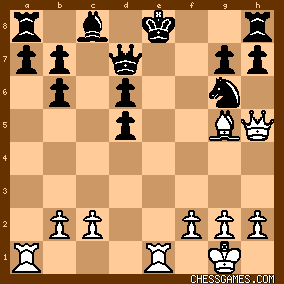
click for larger view16... Kf8
Tartakower-DuMont state that 16...Kf7 here would have been a mistake in light of 17. Re7+ QxR 18. BxQ KxB, but after 19. f4 (much better than wwall's suggested 19. Re1+ Kd8 20. Qxe5 Re8 which should yield at least a draw for Black) White's active position and extra Queen is probably at best sufficient compensation for Black's extra Rook, Bishop, Knight and two pawns and a draw once again seems the most likely outcome. The text, however, is simpler than 16...Kf7 and leads to a draw in more spectacular fashion. 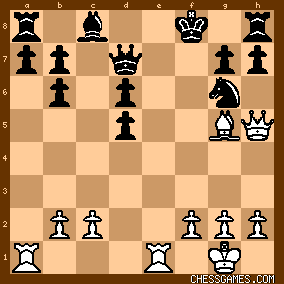
click for larger view17. Ra3!
This quiet move is in my mind the most thrilling part of the drawing combination hatched by Maroczy and Halprin. "The subsidiary idea underlying White's 7th move now becomes clear. The threat is 17. 18. Rf3+ Kg8 19. Rf7 Qc6 (if 19...NxR 20. Qf7 mate) 20. Rf8+ KxR 21. Qf3+ with mate in three to follow." (Tartakower-DuMont. This threat is also correctly noted in wwall's commentary on this site. 17... Ne5
17...Qf7 probably also draws.

click for larger view18. RxN
"!"--(Tournament Book)
"Looks like a forced draw." (wwall)
"This further sacrifice is the key to the whole variation which bristles with pitfalls and it says much for Pillsbury that he found the correct moves to the end." (Sergeant-Watts). "An eliminating sacrifice. White is intent on removing all obstacles from his path." (Tartakower-DuMont). 18... dxR
19. Rf3+ Kg8
"Has the Black King at last reached safety?" (Tartakower-DuMont). 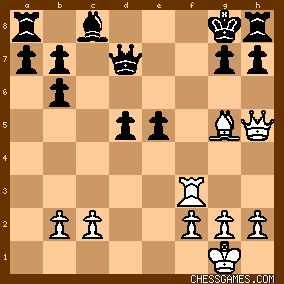
click for larger view20. Bh6
"!!"--(Tournament Book).
"The only move to draw." (wwall).

click for larger view |
|
Apr-21-19
 | | KEG: Post III
20... Qe7
As Tartakower-DuMont and wwall have pointed out, 20...gxB would lose to 21. Rg3+ Kf8 (21...Qg4 sacrificing the Queen is probably better but also loses--albeit more prosaically--after 22. RxQ+ BxQ 23. QxB+ and White's Queen is better placed to wreck havoc than are Black's two Rooks) 22. Qxe5 Qf5 23. Qg7+ Ke8 24. Re3+ Be6 25. QxR+ Qf8 26. Qxh7 Qe7 27. Qh8+ Qf8 28. RxB+ Kd7 29. Qe5. The text, however, was sufficient to draw. 20...e4 also draws. But after 20...Qe7, Halprin/Maroczy had one more brilliant stroke in store for Pillsbury: 
click for larger view21. Bxg7
As only wwall has figured out, 21. Rg3 also draws. Tartakower-Dumont thought that 21. Rg3 would be foiled by 21...g6, but Black then gets mated after 22. Rxg6+! Kf7 (if 22...hxR 23. Qxg6+ and mates next move) 23. Rxb6+ Kg8 24. Rf6 Bf5 25. QxB QxR 26. QxQ and mate next move. The correct move after 21. Rg3 that draws for Black is wwall's 21...Be6. Returning to the game after 21. Bxg7:
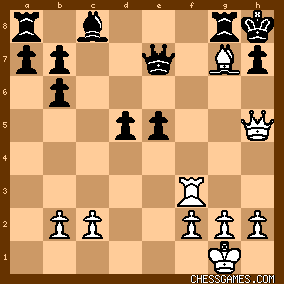
click for larger view21... KxB
Pillsbury here found the only move to save the game. If 21...QxB 22. Qe8+ and mate next move. (Tartakower-DuMont). If 21...Bg4 22. QxB h5 (not 22...QxB 23. Qe6+) 23. Qg6 QxB 24. Qe6+ Kh7 25. Rf5 Qg6 26. Rf7+ Kh6 27. Rf6 Rhg8 28. RxQ+ RxR 29. Qxe5 and White's active Queen should prevail against Black's two Rooks. (Tartakower-DuMont). Pillsbury was now a Rook, Bishop, and pawn to the good, but could not win: 
click for larger view22. Rg3+
"The only move to draw." (wwall).
22... Kf8
As wwall has pointed out, 22...Kf6 loses to 23. Qh6+ Kf7 24. Rg7+ 23. Rf3+ Kg7
Or 23...Kg8
24; Rg3+ Kf8
25. Rf3+ Kg8
1/2 -- 1/2
Magnificent! |
|
| May-19-19 | | Marcelo Bruno: A true sacrifice orgy justified by quick development! |
|
| May-25-22 | | Saniyat24: https://youtu.be/lYuWg-NgouM |
|
May-29-22
 | | Fischerfriend: Early improvement:
After 14.b6 there's no need to take the b pawn.
Black has the so desired castling within reach and had better play:
14..0-0!
There might follow:
- 15.ba b6 followed by Bb7 and pawn a7 is nothing to be afraid of for Black
- 15.Ra7: Rb8 and there's no strong follow up for white. It turns out that both Qh5 and Ra7 are on lonely missions to nowhere.
This was discovered by my brother-in-law Gerard, 2 days ago, during a family chess meeting at my place.
Yesterday I checked it with the computer. There seems nothing wrong with 14..0-0.
Pillsbury could have saved himself a lot of trouble by ignoring the b pawn and castle into
safety! But then he would have robbed us of this spectacular game. I had prepared the Halprin-Pillsbury game as a fine example to show how good top players did in 1900. Now and then anyway. Without computers but with common sense they produced some good games. |
|
Jul-16-23
 | | GrahamClayton: I had a look at 14.Nd5 instead of 14.b6 - 14. Nd5 exd5 15. Rae1+ Kf8 16. f4 Qg4 17. Qxg4 Bxg4 18. f5 Ne5 19. h3 Bh5 20. f6 looks interesting. |
|
 |
|
< Earlier Kibitzing · PAGE 2 OF 2 ·
Later Kibitzing> |





